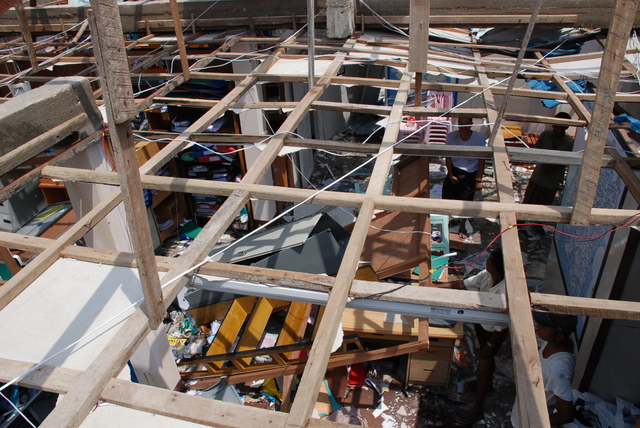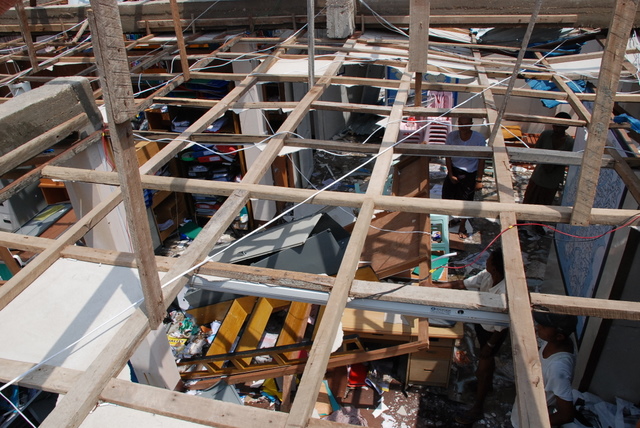The Organization
At the invitation of the local Government and more particularly at their own initiative in the belief that it is their corporate and social responsibility to assist with the Cyclone Relief… many local companies started organizing themselves soon after the event.
The Cape Negrais Relief Group is made up of several (5) local companies and has taken on responsibility to provide relief work in the Western Ayeyarwaddy arena –Ngapudaw Township. Over the past weeks as we move onto reconstruction, each company has chosen to work in key areas, as the Western Ayeyarwaddy Delta (tip)… is the arguably the most inaccessible of the various disaster zones. The SPA group is now working mainly on “Middle Island” (Alekyun in Burmese).
Travel Logisitics
• Pathein is the largest town for the Area… (is 5 hours by car from Rangoon).
• Ngapudaw, the township capital (is 6 hours by boat from Pathein, down the Ayeyarwaddy River)
• Middle Island is another 5 hours from Ngapudaw… towards the mouth of the Delta Initial assessments

My former colleague (Dr. Ye from PHIH) together with senior managers from the Group went on a reconnaissance trip and was one of the earliest outsiders there, on May 10 to assess the area for medical and relief work. They met with the local community leaders (headmen of villages), army and naval commanders as well as the township medical staff.
Several “idwife –on mobile centers” lost their lives during the cyclone, a “doctor” was reported to have deserted from his base hospital… Structural damages on the “brick buildings” in the bigger villages were the loss of the upper floors and for the normal “huts ,“ these were completely wiped out. Rice shortage was noted but as the rains were starting, “clean” water was not a major issue and no major outbreaks were being reported… The team returned to report and initial relief work started, based on this. Assessments are of course, continually ongoing.
Medical Relief Work
Normal Healthcare delivery in the Delta is organized under the Township.
• Township Hospital (30+ beds) with 2~5 doctors –rural GPs that do all!!
• Station Hospital (16+ beds) with 1~2 doctors – rural GPs that do all!!
• Station & Rural Health Center = Ambulatory Center with NO resident doctors
• Sub‐Rural Health Center = mobile teams (Health Visitor +/‐ Midwife)
Cape Negrais Relief: Summary of the past couple of weeks
Major problems are normally referred to the District General Hospital (100+ beds) –where basic “general” specialists in a number of disciplines are available. It goes without saying that staffing is poor and resources are weak at all levels!
Major Injuries
At the beginning, seriously injured were moved to the District General Hospital at Pathein… as I write, I am still unable to obtain clear statistics as to the patient loads and future requirements for specialty /super‐specialty reconstruction work. The local medical aid organizations are trying to help and compile a comprehensive analysis and I will forward this as we go on.
Community Care
Pre‐fabricated 2 storey structures have been shipped from Pathein and erected and temporary bases. At Thin Gan Gon TGG), a town the center of Middle Island, one was erected within a “chool”ground as a temporary hospital. Volunteer doctors & nurses (12~) from Yangon led by Dr Ye, my former colleague from PHIH are currently on 2 weekly rotation from this base. In this TGG town, there are about 1000+ displaced persons (more throughout the Island) from the coastal villages that have been completely wiped out. Fortunately, there is no outbreak (either water borne or otherwise –espite Dengue being endemic and Malaria in nearby areas); wound care for minor injuries sustained during the Cyclone is being provided. However, there is significant post traumatic stress which is hard to manage as the villagers are traipsing in droves as they hear about “ree”medical care and medications. So the bulk of the work is basic primary care.
The Pandaw “hospital ship”
This was commandeered by Save the Children (StC) and staffed with 2 Malaysian doctors but the docs were off‐load by the local authorities before reaching their destination. The “oat”moreover is not suited for the “iverine delta”environment and the engine broke down soon after. Currently it is moored in Nga Pu Daw, the township capital being repaired. While there it is being used as GP practice center manned by local volunteer doctors.
“Needs”
There are adequate local medical volunteers ‘for the time being’… they are being crashed trained at the Command Center in Rangoon before being shipped out for a rotation. However over the coming months there will be a need for more volunteers to work at this level. The community does not speak “English” and our ability to provide suitable translators is definitely a crucial issue. We are currently compiling a list of volunteers to work at the primary care level. Obviously “Myanmar” or Burmese speakers would be an asset. I will send more on this later.
Food & Water
The rainy season is due to start pumping out the salt water flooded ponds means that there is “fresh” albeit brackish water for the time being. World Food Program has undertaken to be responsible for food for the coming 12 months through its various executive arms and subcontractors (e.g. MSF, StCF)… donations for clothes etc from overseas are not appropriate (as the local dress needs are basic… longyi‐sarong and a top).
Shelter
The UK Shelter Box(es) in principal are a good idea but TENTS are hard to live in when temp & humidity is very high! Reconstruction in bamboo and thatch is the optimum.
The current phase: Major Relief Work
Aim
We will start with our own current limited resources and extend the program to provide a comprehensive relief & reconstruction program for “Middle Island –Ale‐kyun ”with donors’assistance.
Objectives
These are the key areas in each village community that we plan to rehabilitate.
• Housing / Shelter
• Power supply
• Water / Sanitation
• Education
• Health
• Transport
• Livelihood / Economy
We will provide replacement housing. Beyond that shelter against similar future events (e.g. in school or monastery) is planned. A comprehensive infra‐structure that provides self‐sustainable power (electricity), running water and sanitation will be part of the basic development. To ensure that the community who are now subsistence level –rice farmers, fishermen or seasonal salt farmers have a sustainable future/livelihood, a micro‐credit financing program will also be established.
Current Plans
We are making detailed assessment. Our survey team returns by the end of this week. Following a proper planning, we will start to rebuild a “model” village using our resources… this will give us critical information on the unit cost for building homes, utilities, school etc.., and as we complete our master plan and our first model village, we plan to provide specific details to you all. We envisage that health and education will revert to the responsible local authorities to service, though for health we believe that “international volunteer NGOs’ help to provide services may be necessary for sometime (e.g. 1~2 years).
I am instituting a database as well as establishing a website of the relief effort (the bulletins that we send maybe accessed directly). This will provide timely access to information for all of you.

